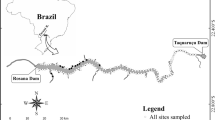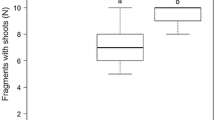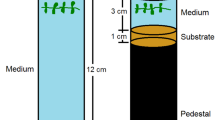Abstract
The success of invasive macrophytes is due to the ability of introduced fragments to survive, regenerate and colonise freshwaters. In this study, carried out in an experimental garden, we evaluated: (i) the ability of Myriophyllum aquaticum fragments with or without an apex, to survive and colonise and (ii) the effects of a macrophyte bed on the colonisation success of two non-native species (Ludwigia grandiflora, M. aquaticum). Fragments of M. aquaticum with apical stems had the highest survival rate (85 vs. 62%) and colonisation abilities (i.e. 9% of rate of anchorage with a macrophyte bed). The anchorage rate of L. grandiflora was stimulated by the presence of the non-native Elodea canadensis and the relative growth rate of M. aquaticum fragments was higher in the presence of a L. grandiflora bed. Facilitation may enhance the colonisation of some non-native species during the first stage of invasion (colonisation and regeneration). However, the presence of a macrophyte bed limits the chances of L. grandiflora rooting in the sediment. This result suggests that spatial competition may occur at the beginning of growth in shallow waters. Competitive or facilitative interactions between neighbouring species depend both on the introduced species and on macrophyte bed composition.





Similar content being viewed by others
References
Abrams, P., 1983. The theory of limiting similarity. Annual Review of Ecology and Systematics 14: 359–376.
Agami, M. & Y. Waisel, 1986. The ecophysiology of roots of submerged vascular plants. Physiologie Vegetale 24: 607–624.
Ballais, C., 1969. Plantes adventices de la Gironde. Le Monde des plantes 365: 5–9.
Barrat-Segretain, M. H., 2005. Competition between invasive and indigenous species: impact of spatial pattern and developmental stage. Plant Ecology 180: 153–160.
Barrat-Segretain, M. H. & G. Bornette, 2000. Regeneration and colonization abilities of aquatic plant fragments: effect of disturbance seasonality. Hydrobiologia 421: 31–39.
Barrat-Segretain, M. H. & B. Cellot, 2007. Response of invasive macrophyte species to drawdown: the case of Elodea sp. Aquatic Botany 87: 255–261.
Barrat-Segretain, M. H., G. Bornette & A. Hering-Vilas-Boas, 1998. Comparative abilities of vegetative regeneration among aquatic plants growing in disturbed habitats. Aquatic Botany 60: 201–211.
Barrat-Segretain, M. H., C. P. Henry & G. Bornette, 1999. Regeneration and colonization of aquatic plant fragments in relation to the disturbance frequency of their habitats. Archiv für Hydrobiologie 145: 111–127.
Callaway, R. M. & L. King, 1996. Temperature-driven variation in substrate oxygenation and the balance of competition and facilitation. Ecology 77: 1189–1195.
Chadwell, T. B. & K. A. M. Engelhardt, 2008. Effects of pre-existing submersed vegetation and propagule pressure on the invasion success of Hydrilla verticillata. Journal of Applied Ecology 45: 515–523.
Cook, C. D. K. & K. Urmi-König, 1985. A revision of the genus Elodea (Hydrocharitaceae). Aquatic Botany 21: 111–156.
Cushman, J. H., C. J. Lortie & C. E. Christian, 2011. Native herbivores and plant facilitation mediate the performance and distribution of an invasive exotic grass. Journal of Ecology 99: 524–531.
de Sousa, W. T. Z., S. M. Thomaz & K. J. Murphy, 2010. Response of native Egeria najas Planch and invasive Hydrilla verticillata (L.f.) Royle to altered hydroecological regime in a subtropical river. Aquatic Botany 92: 40–48.
Dukes, J. S., 2001. Biodiversity and invasibility in grassland microcosms. Oecologia 126: 563–568.
Dutartre, A., J. Haury, S. Dandelot, J. Coudreuse, B. Ruaux, E. Lambert, P. Le Goffe & M. J. Menozzi, 2007. Les Jussies: caractérisation des relations entre sites, populations et activités humaines. Implications pour la gestion. Programme de recherche “Invasions Biologiques” 2003–2006, 128 pp.
Emery, S. M., 2007. Limiting similarity between invaders and dominant species in herbaceous plant communities? Journal of Ecology 95: 1027–1035.
Fargione, J. E. & D. Tilman, 2005. Diversity decreases invasion via both sampling and complementarity effects. Ecology Letters 8: 604–611.
Fargione, J. E., C. S. Brown & D. Tilman, 2003. Community assembly and invasion: an experimental test of neutral versus niche processes. Proceedings of the National Academy of Sciences 100: 8916–8920.
Flory, S. L. & J. T. Bauer, 2014. Experimental evidence for indirect facilitation among invasive plants. Journal of Ecology 102: 12–18.
Funk, J. L., E. E. Cleland, K. N. Suding & E. S. Zavaleta, 2008. Restoration through reassembly: plant traits and invasion resistance. Trends in Ecology & Evolution 23: 695–703.
Hao, B., H. Wu, Q. Shi, G. Liu & W. Xing, 2013. Facilitation and competition among foundation species of submerged macrophytes threatened by severe eutrophication and implications for restoration. Ecological Engineering 60: 76–80.
Hofstra, D. E., J. Clayton, J. D. Green & M. Auger, 1999. Competitive performance of Hydrilla verticillata in New Zealand. Aquatic Botany 63: 305–324.
Hooper, D. U. & J. S. Dukes, 2004. Over yielding among plant functional groups in a long-term experiment. Ecology Letters 7: 95–105.
Hooper, D. U. & J. S. Dukes, 2010. Functional composition controls invasion success in a California serpentine grassland. Journal of Ecology 98: 764–777.
Hunt, R., 2003. Plant growth analysis: individual plants. In Thomas, B., D. J. Murphy & D. Murray (eds), Encyclopaedia of Applied Plant Sciences. Academic Press, London: 579–588.
Hussner, A., 2009. Growth and photosynthesis of four invasive aquatic plant species in Europe. Weed Research 49: 506–515.
Hussner, A., 2010. Growth response and root system development of the invasive Ludwigia grandiflora and Ludwigia peploides to nutrient availability and water level. Fundamental and Applied Limnology 177: 189–196.
Hussner, A., C. Meyer & J. Busch, 2009. Influence of water level on growth and root system development of Myriophyllum aquaticum (Vell.) Verdcourt. Weed Research 49: 73–80.
Kuebbing, S. E., M. A. Nuñez & D. Simberloff, 2013. Current mismatch between research and conservation efforts: the need to study co-occurring invasive plant species. Biological Conservation 160: 121–129.
Le Bagousse-Pinguet, Y., P. Liancourt, N. Gross & D. Straile, 2012. Indirect facilitation promotes macrophyte survival and growth in freshwater ecosystems threatened by eutrophication. Journal of Ecology 100: 530–538.
Levine, J. M., 1999. Indirect facilitation: evidence and predictions from a riparian community. Ecology 80: 1762–1769.
Matheson, F. E., M. D. de Winton, J. S. Clayton, T. M. Edwards & T. J. Mathieson, 2005. Responses of vascular (Egeria densa) and non-vascular (Chara globularis) submerged plants and oospores to contrasting sediment types. Aquatic Botany 83: 141–153.
Michelan, T. S., S. M. Thomaz, R. P. Mormul & P. Carvalho, 2010. Effects of an exotic-invasive macrophyte (tropical signal grass) on native plant community composition, species richness and functional diversity. Freshwater Biology 55: 1315–1326.
Nultsch, W., 2001. Allgemeine Botanik. Thieme, Stuttgart, New York: 663 pp.
Rejmánková, E., 1992. Ecology of creeping macrophytes with special reference to Ludwigia peploides (H. B. K.) Raven. Aquatic Botany 43: 283–299.
Riis, T., 2008. Dispersal and colonisation of plants in lowland streams: success rates and bottlenecks. Hydrobiologia 596: 341–351.
Riis, T., T. V. Madsen & R. S. H. Sennels, 2009. Regeneration, colonisation and growth rates of allofragments in four common stream plants. Aquatic Botany 90: 209–212.
Santamaría, L., 2002. Why are most aquatic plants widely distributed? Dispersal, clonal growth and small-scale heterogeneity in a stressful environment. Acta Oecologica 23: 137–154.
Santos, M. J., L. W. Anderson & S. L. Ustin, 2011. Effects of invasive species on plant communities: an example using submersed aquatic plants at the regional scale. Biological Invasions 13: 443–457.
Shekhar, R. B. & A. U. Mallik, 2010. Disturbance effects on species diversity and functional diversity in riparian and upland plant communities. Ecology 91: 28–35.
Sheppard, A. W., R. H. Shaw & R. Sforza, 2006. Top 20 environmental weeds for classical biological control in Europe: a review of opportunities, regulations and other barriers to adoption. Weed Research 46: 93–117.
Silveira, M. J., S. M. Thomaz, R. P. Mormul & F. P. Camacho, 2009. Effects of desiccation and sediment type on early regeneration of plant fragments of three species of aquatic macrophytes. International Review of Hydrobiology 94: 169–178.
StatSoft Inc, 2007. STATISTICA. Data Analysis Software System. Version 8.0. www.statsoft.com.
Sytsma, M. D. & L. W. J. Anderson, 1993. Biomass, nitrogen, and phosphorus allocation in Parrotfeather (Myriophyllum aquaticum). Journal of Aquatic Plant Management 31: 244–248.
Tamas, I. A., 1995. Hormonal regulation of apical dormance. In Davies, P. J. (ed.), Plant Hormones. Kluwer, Dordrecht: 572–595.
Thompson, K., O. L. Petchey, A. P. Askew, N. P. Dunnett, A. P. Beckerman & A. J. Willis, 2010. Little evidence for limiting similarity in a long-term study of a roadside plant community. Journal of Ecology 98: 480–487.
Thouvenot, L., J. Haury & G. Thiébaut, 2013a. Strategies of the invasive macrophyte Ludwigia grandiflora in its introduced range: competition, facilitation or coexistence with native and exotic species? Aquatic Botany 107: 8–13.
Thouvenot, L., J. Haury & G. Thiébaut, 2013b. A success story: water primroses, aquatic plant pests. Aquatic Conservation 23: 790–803.
Thouvenot, L., J. Haury & G. Thiébaut, 2013c. Seasonal plasticity of Ludwigia grandiflora under light and water depth gradients: an outdoor mesocosm experiment. Flora 208: 430–437.
Vari, A., 2012. Propagation and growth of submerged macrophytes in Lake Balaton. PhD dissertation. Balaton Limnological Institute, Center of Ecological Research, The Hungarian Academy of Science, Tihany.
Von Holle, B., 2005. Biotic resistance to invader establishment of a southern appalachian plant community is determined by environmental conditions. Journal of Ecology 93: 16–26.
Von Holle, B. & D. Simberloff, 2004. Testing Fox’s assembly rule: does plant invasion depend on recipient community structure? Oikos 105: 551–563.
Wersal, R. M. & J. D. Madsen, 2011. Comparative effects of water level variations on growth characteristics of Myriophyllum aquaticum. Weed Research 51: 386–393.
Wersal, R. M. & J. D. Madsen, 2013. Influences of light intensity variations on growth characteristics of Myriophyllum aquaticum. Journal of Freshwater Ecology 28: 2–14.
Xie, D., D. Yu, L. F. Yu & C. H. Liu, 2010. Asexual propagations of introduced exotic macrophytes Elodea nuttallii, Myriophyllum aquaticum and M. propinquum are improved by nutrient-rich sediments in China. Hydrobiologia 655: 37–47.
Xie, D., D. Yu, W.-H. You & C.-X. Xia, 2013. The propagule supply, litter layers and canopy shade in the littoral community influence the establishment and growth of Myriophyllum aquaticum. Biological Invasions 15: 113–123.
Acknowledgments
We thank Lise Thouvenot and Camille Puech for their helpful assistance in the experimental garden and Nathalie Josselin-Le Bris for their assistance with water analysis.
Author information
Authors and Affiliations
Corresponding author
Additional information
Guest editors: Sidinei M. Thomaz, Katya E. Kovalenko, John E. Havel & Lee B. Kats / Aquatic Invasive Species
Rights and permissions
About this article
Cite this article
Thiébaut, G., Martinez, L. An exotic macrophyte bed may facilitate the anchorage of exotic propagules during the first stage of invasion. Hydrobiologia 746, 183–196 (2015). https://doi.org/10.1007/s10750-014-1982-6
Received:
Revised:
Accepted:
Published:
Issue Date:
DOI: https://doi.org/10.1007/s10750-014-1982-6




